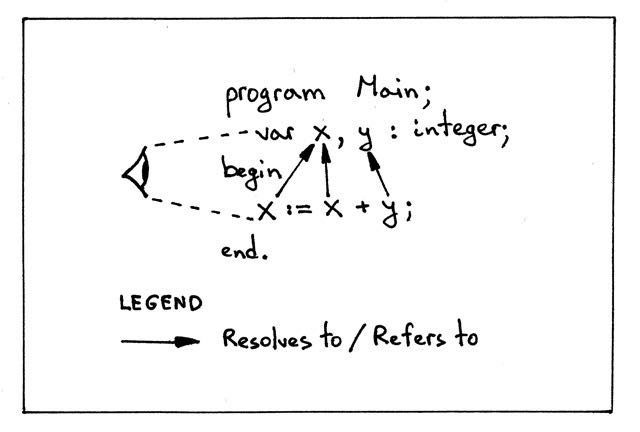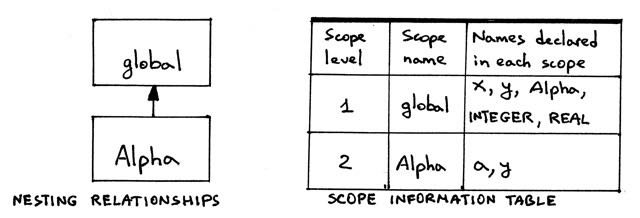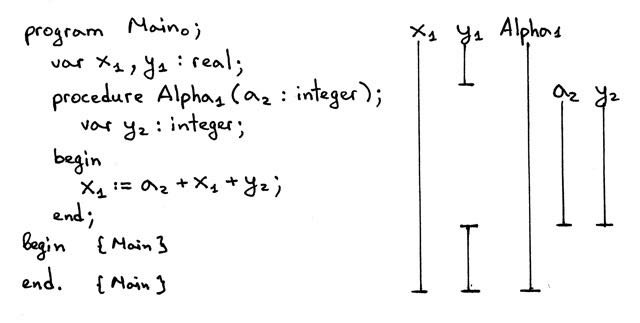本系列是《Let’s Build A Simple Interpreter 》的阅读笔记。
过程的定义 过程声明是一个定义一个标识符(过程名)的语言结构,它将该标识符与一个 Pascal 代码块关联起来。
对于 Pascal 过程和它的声明:
Pascal 过程没有返回语句,它们在到达相应代码块结尾时退出
Pascal 过程可以互相嵌套
无参数过程声明 语法 这是本节的测试程序:
1 2 3 4 5 6 7 8 9 10 11 12 13 14 15 16 17 18 19 20 21 22 23 PROGRAM Part12;VAR a : INTEGER; PROCEDURE P1 ;VAR a : REAL; k : INTEGER; PROCEDURE P2 ; VAR a, z : INTEGER; BEGIN z := 777 ; END ; BEGIN END ; BEGIN a := 10 ; END .
这是修改过的语法:
1 2 3 declarations : VAR (variable_declaration SEMI)+ | (PROCEDURE ID SEMI block SEMI)* | empty
过程声明子规则包含了保留关键字 PROCEDURE 后跟一个标识符(过程名),后跟一个分号,后再跟一个 block 规则,最后由分号结尾。
lexer 增加一个名为 PROCEDURE 的 token,并将其添加到保留关键字中:
1 2 3 4 5 6 7 8 9 10 RESERVED_KEYWORDS = { 'PROGRAM' : Token('PROGRAM' , 'PROGRAM' ), 'VAR' : Token('VAR' , 'VAR' ), 'DIV' : Token('DIV' , 'DIV' ), 'INTEGER' : Token('INTEGER' , 'INTEGER' ), 'REAL' : Token('REAL' , 'REAL' ), 'BEGIN' : Token('BEGIN' , 'BEGIN' ), 'END' : Token('END' , 'END' ), 'PROCEDURE' : Token('PROCEDURE' , 'PROCEDURE' ), }
parser
新增 ProcedureDecl AST 结点。ProcedureDecl AST 结点代表了一个过程声明。它的构建函数接受过程名和代码块的 AST 结点作为参数:
1 2 3 4 class ProcedureDecl (AST ): def __init__ (self, proc_name, block_node ): self.proc_name = proc_name self.block_node = block_node
修改 parser 的 declarations 方法以支持过程声明:
1 2 3 4 5 6 7 8 9 10 11 12 13 14 15 16 17 18 19 20 21 22 23 24 25 def declarations (self ): """declarations : VAR (variable_declaration SEMI)+ | (PROCEDURE ID SEMI block SEMI)* | empty """ declarations = [] if self.current_token.type == VAR: self.eat(VAR) while self.current_token.type == ID: var_decl = self.variable_declaration() declarations.extend(var_decl) self.eat(SEMI) while self.current_token.type == PROCEDURE: self.eat(PROCEDURE) proc_name = self.current_token.value self.eat(ID) self.eat(SEMI) block_node = self.block() proc_decl = ProcedureDecl(proc_name, block_node) declarations.append(proc_decl) self.eat(SEMI) return declarations
interpreter 在 Interpreter 类中增加一个新的空的 visit_ProcedureDecl 方法,这会让的解释器忽略所有的过程声明:
1 2 def visit_ProcedureDecl (self, node ): pass
有参数过程声明 符号作用域表 作用域的概念这里不再赘述,至少使用过一门编程语言的同学对整个概念都很了解。Pascal 程序所用的被称为词法作用域(lexically scoped),又叫做静态作用域,因为你可以只看源码而不用执行这个程序,单纯根据文本规则就可以确定哪个名字(引用)会解析到哪个声明。例如在 Pascal 中,像 program end 这样的词法 关键字就划定了一个作用域的文本边界:
当我们讨论嵌套作用域时,使用作用域级别 来表示它们的嵌套关系会很方便。通过名字 来指代作用域也会很方便。当开始讨论嵌套作用域时,我们会同时使用作用域级别和作用域名字。符号作用域表(scoped symbol table)可以很好地描述下面这两个信息:
每个变量(符号)都是在哪一级别被声明的
一个变量名引用了哪一级别的哪个声明
为了实现符号作用域表,需要增强 SymbolTable 类,将其重命名为类 ScopedSymbolTable,添加两个新的字段 scope_level 和 scope_name,并修改符号作用域表的构造函数。
1 2 3 4 5 6 7 8 9 10 11 12 13 14 15 16 17 18 19 20 21 22 23 24 25 26 27 28 29 30 31 32 33 34 35 36 37 38 39 40 class ScopedSymbolTable (): def __init__ (self, scope_name, scope_level ): self._symbols = OrderedDict() self.scope_name = scope_name self.scope_level = scope_level self._init_builtins() def _init_builtins (self ): self.insert(BuiltinTypeSymbol('INTEGER' )) self.insert(BuiltinTypeSymbol('REAL' )) def __str__ (self ): h1 = 'SCOPE (SCOPED SYMBOL TABLE)' lines = ['\n' , h1, '=' * len (h1)] for header_name, header_value in ( ('Scope name' , self.scope_name), ('Scope level' , self.scope_level), ): lines.append('%-15s: %s' % (header_name, header_value)) h2 = 'Scope (Scoped symbol table) contents' lines.extend([h2, '-' * len (h2)]) lines.extend( ('%7s: %r' % (key, value)) for key, value in self._symbols.items() ) lines.append('\n' ) s = '\n' .join(lines) return s __repr__ = __str__ def insert (self, symbol ): print ('Insert: %s' % symbol.name) self._symbols[symbol.name] = symbol def lookup (self, name ): print ('Lookup: %s' % name) symbol = self._symbols.get(name) return symbol
下面是一段展示语义分析器如何实例化 ScopedSymbolTable 类的代码:
1 2 3 4 class SemanticAnalyzer (NodeVisitor ): def __init__ (self ): self.scope = ScopedSymbolTable(scope_name='global' , scope_level=1 ) ...
带有形式参数的过程声明 1 2 3 4 5 6 7 8 9 10 11 12 program Main;var x, y: real;procedure Alpha (a : integer) ;var y : integer;begin x := a + x + y; end ;begin end .
上面这段示例程序包含一个带参数的过程。下面是为了支持带参数的过程声明所要做的修改:
增加 Param AST 结点
1 2 3 4 class Param (AST ): def __init__ (self, var_node, type_node ): self.var_node = var_node self.type_node = type_node
修改 ProcedureDecl 结点的构建函数以接受一个额外的参数: params
1 2 3 4 5 class ProcedureDecl (AST ): def __init__ (self, proc_name, params, block_node ): self.proc_name = proc_name self.params = params self.block_name = block_name
修改 declarations 规则以反映过程声明子规则的变化
1 2 3 4 5 def declarations (self ): """declarations : (VAR (variable_declaration SEMI)+)* | (PROCEDURE ID (LPAREN formal-parameter_list RPAREN)? SEMI block SEMI)* | empty """
增加 formal_parameter_list 规则和方法
1 2 3 4 def formal_parameter_list (self ): """ formal_parameter_list : formal_parameters | formal_parameters SEMI formal_parameter_list """
增加 formal_parameters 规则和方法
1 2 3 def formal_parameters (self ): """ formal_parameters : ID (COMMA ID)* COLON type_spec """ param_nodes = []
下面是示例程序对应的 AST:
过程符号 和变量声明和内置类型声明一样,对于过程也有一个单独的符号类:
1 2 3 4 5 6 7 8 9 10 11 12 13 14 class ProcedureSymbol (Symbol ): def __init__ (self, name, params=None ): super (ProcedureSymbol, self).__init__(name) self.params = params if params is not None else [] def __str__ (self ): return '<{class_name}(name={name}, parameters={params})>' .format ( class_name=self.__class__.__name__, name=self.name, params=self.params, ) __repr__ = __str__
过程符号有一个名字(即过程名),它们的类别是过程(被编码进了类名),类型是 None 因为在 Pascal 中过程不返回任何东西。过程符号还保存了关于过程声明的附加信息,即如上面的代码所示,它保存了过程的形参。加上过程符号,新的符号层级如下所示:
嵌套作用域 为了讨论方便,本节使用一个修剪过的程序版本。下面的版本没有变量引用,只有变量和过程声明:
1 2 3 4 5 6 7 8 9 10 11 12 program Main; var x, y : real; procedure Alpha (a : integer) ; var y : integer; begin end ; begin end .
在声明一个新的过程时,就引入了一个新的作用域,而这个作用域嵌套在了由 PROGRAM 引入的全局作用域,所以这是一个有嵌套作用域的 Pascal 程序的例子。一个过程的作用域就是这个过程的整个主体。过程作用域的开始是由关键字 PROCEDURE 标识的,而由关键字 END 和一个分号标识结束。
关键字 PROGRAM 和 PROCEDURE 会引入新的作用域。在 AST 中,相应的结点是 Program 和 ProcedureDecl 。因此需要修改 visit_Program 方法并增加 visit_ProcedureDecl 方法来创建作用域符号表:
1 2 3 4 5 6 7 8 9 10 11 12 13 14 15 16 17 18 19 20 21 22 23 24 25 26 27 28 29 30 31 32 33 34 35 36 37 38 39 40 41 42 def visit_Program (self, node ): print ('ENTER scope: global' ) global_scope = ScopedSymbolTable( scope_name='global' , scope_level=1 , ) self.current_scope = global_scope self.visit(node.block) print (global_scope) print ('LEAVE scope: global' ) def visit_ProcedureDecl (self, node ): proc_name = node.proc_name proc_symbol = ProcedureSymbol(proc_name) self.current_scope.insert(proc_symbol) print ('ENTER scope:%s' % proc_name) procedure_scope = ScopedSymbolTable( scope_name=proc_name, scope_level=2 , ) self.current_scope = procedure_scope for param in node.params: param_type = self.current_scope.lookup(param.type_node.value) param_name = param.var_node.value var_symbol = VarSymbol(param_name, param_type) self.current_scope.insert(var_symbol) proc_symbol.params.append(var_symbol) self.visit(node.block_node) print (procedure_scope) print ('LEAVE scope: %s' % proc_name)
内存中的作用域看上去像下面这样,只是两个独立的作用域符号表:
INTEGER 和 REAL 存在于两个作用域符号表中,原因是我们为每一个作用域都新建了单独的作用域符号表。
作用域树:作用域符号表链 通过在作用域符号表之间创建一个连接来把它们链在一起,这种方式就像一棵树(作用域树):
代码方面的修改主要包括两点:
修改 ScopedSymbolTable 类,增加一个变量 enclosing_scope 用来保存包含该作用域的作用域。这就是上面图中两个作用域之间的连接
修改 visit_Program 和 visit_ProcedureDecl 这两个方法,使用修改过的 ScopedSymbolTable 类来创建一个指向所嵌套于的作用域的真实的连接
1 2 3 4 5 6 7 8 9 10 11 12 13 14 15 16 17 18 19 20 21 22 23 24 25 26 27 28 29 30 31 32 33 34 35 36 37 38 39 40 41 42 43 44 45 46 47 48 49 50 51 52 53 54 55 56 57 58 59 class ScopedSymbolTable (object ): def __init__ (self, scope_name, scope_level, enclosing_scope=None ): self._symbols = OrderedDict() self.scope_name = scope_name self.scope_level = scope_level self.enclosing_scope = enclosing_scope self._init_builtins() ... def visit_Program (self, node ): print ('ENTER scope: global' ) global_scope = ScopedSymbolTable( scope_name='global' , scope_level=1 , enclosing_scope=self.current_scope, ) self.current_scope = global_scope self.visit(node.block) print (global_scope) self.current_scope = self.current_scope.enclosing_scope print ('LEAVE scope: global' ) def visit_ProcedureDecl (self, node ): proc_name = node.proc_name proc_symbol = ProcdureSymbol(proc_name) self.current_scope.insert(proc_symbol) print ('ENTER scope: %s' % proc_name) procedure_scope = ScopedSymbolTable( scope_name=proc_name, scope_level=self.current_scope.scope_level + 1 , enclosing_scope=self.current_scope ) self.current_scope = procedure_scope for param in node.params: param_type = self.current_scope.lookup(param.type_node.value) param_name = param.var_node.value var_symbol = VarSymbol(param_name, param_type) self.current_scope.insert(var_symbol) proc_symbol.params.append(var_symbol) self.visit(node.block_node) print (procedure_scope) self.current_scope = self.current_scope.enclosing_scope print ('LEAVE scope: %s' % proc_name)
可以把上面的作用域树想象成一组作用域栈。
嵌套作用域和名字解析 下面是一个包含变量引用的示例程序:
1 2 3 4 5 6 7 8 9 10 11 12 program Main; var x, y: real; procedure Alpha (a : integer) ; var y : integer; begin x := a + x + y; end ; begin end .
像 Pascal 这样的词法(静态)作用域语言在解析名字时遵循最近嵌套作用域 (the most closely nested scope)原则。它的意思是,在每个作用域中,一个名字解析为词法上最近的声明。为了实现这样的查找行为,需要先在当前作用域中进行查找,再从外一层的作用域中查找,一直重复直到找到或者到达了作用域树的最顶层而没有作用域。只需要简单地扩展一下 ScopedSymbolTable 类中的 lookup 方法,使它继续沿着作用域树向上查找就行了:
1 2 3 4 5 6 7 8 9 10 11 12 def lookup (self, name ): print ('Lookup: %s. (Scope name: %s)' % (name, self.scope_name)) symbol = self._symbols.get(name) if symbol is not None : return symbol if self.enclosing_scope is not None : return self.enclosing_scope.lookup(name)







